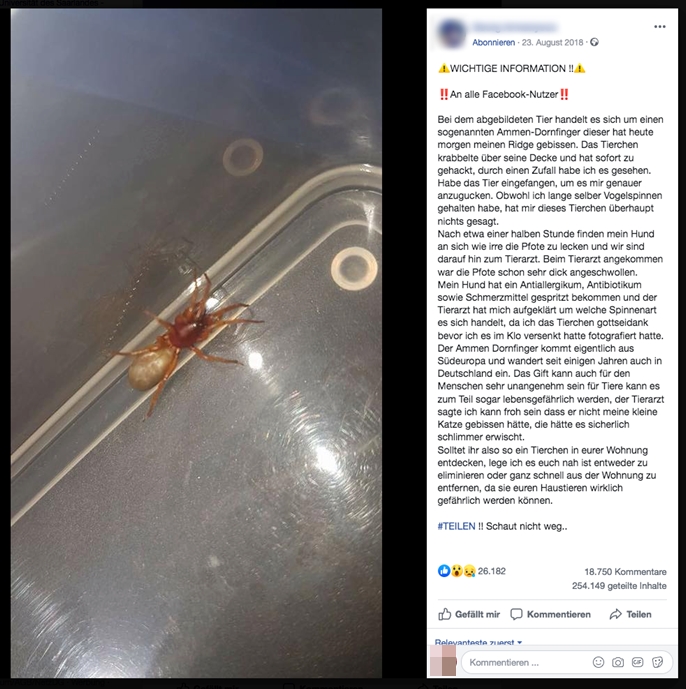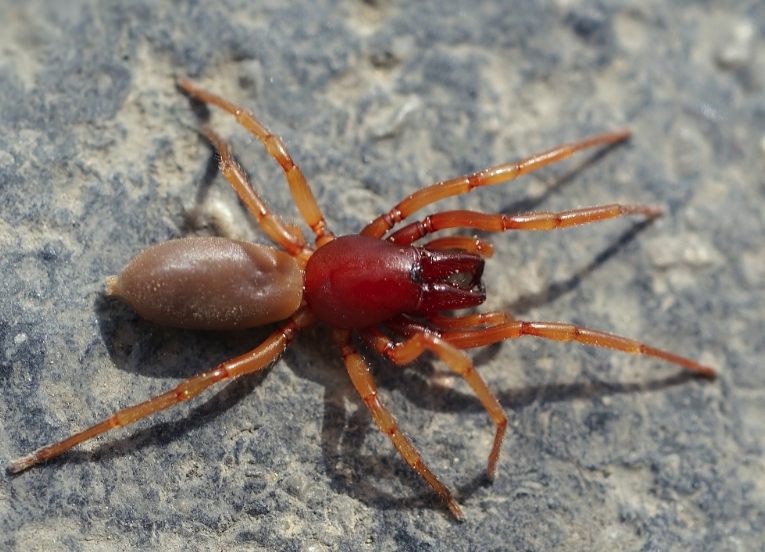Not only can you make an elephant out of a mosquito, you can also make an elephant out of a spider.
Summertime is spider time and now they are circulating again on social networks, the horror stories of the evil, evil nurse's thornfinger (Cheiracanthium punctorium). Thanks to climate change, it is now becoming increasingly common in Germany and its viciousness means it bites adults, children and pets indiscriminately, with the very worst consequences.
And the stories are eagerly shared, even if they come from the previous year, like this message here.

The author seems to be familiar with tarantulas, but not with other spiders, because this is not a nurse's thrush but rather a large isopod hunter (Dysdera crocata).
Like the nurse's thorn finger, the water spider and the house angle spider, it is also one of the few large spiders in this country that, with its powerful mouthparts, is theoretically able to bite a person or a larger mammal if it feels threatened.

However, the probability of this is rather low because it lives where woodlice also live: under stones, tree trunks and holes in the ground, sometimes even in damp cellars.
Actual threat
In the case of the Dornfinger it is even lower because it prefers meadows, fallow fields or forest clearings as its habitat and is only rarely found in human dwellings. And it hasn't just been living out there recently; there has been evidence of the nurse's thorn finger in the southern half of Germany since the beginning to mid-19th century.
And since then there have been repeated bites, but the numbers are manageable, as are the consequences. In 2006, according to a study in the American Journal of Tropical Medicine and Hygiene, there were only 12 confirmed thorn finger bites* across Europe, all without serious health consequences. In comparison, it is much more likely to be stung by a bee or wasp. Which, statistically speaking, is much more dangerous, because a sting can quickly become life-threatening, especially for allergy sufferers.
[mk_ad]
There are no reliable figures for the total number of stings from these hymenoptera, but in the year 2006 mentioned above, according to information from the Federal Statistical Office, there were 29 confirmed deaths from bee and wasp stings in Germany alone (according to ICD 10 E 905.3)**, the number is unreported estimated to be quite a bit higher.
Conclusion
It's not all that wild! Like the caiman in the quarry lake or Bruno, the problem bear, the evil, evil Thornfinger is also a classic summer slump theme in which the perceived threat is disproportionate to the actual danger.
It's true that thorn fingers can bite people, the woodlouse hunter from the Facebook post can too, and in an emergency even the dog. Both are certainly not a real, comprehensive threat to life and limb and there are much more dangerous crawling creatures such as wasps, bees or ticks that do not shy away from contact with humans and which are present in large numbers seasonally.
But disgusting spiders obviously have a higher scare factor than annoying wasps or annoying ticks, so we're looking forward to supposed killer spiders again in 2020, right in the middle of Germany.
Sources: * Wikipedia , ** MH-Hannover (PDF, page 8)
Article image: Wikipedia / Rainer Altenkamp, Berlin
Notes:
1) This content reflects the current state of affairs at the time of publication. The reproduction of individual images, screenshots, embeds or video sequences serves to discuss the topic. 2) Individual contributions were created through the use of machine assistance and were carefully checked by the Mimikama editorial team before publication. ( Reason )

